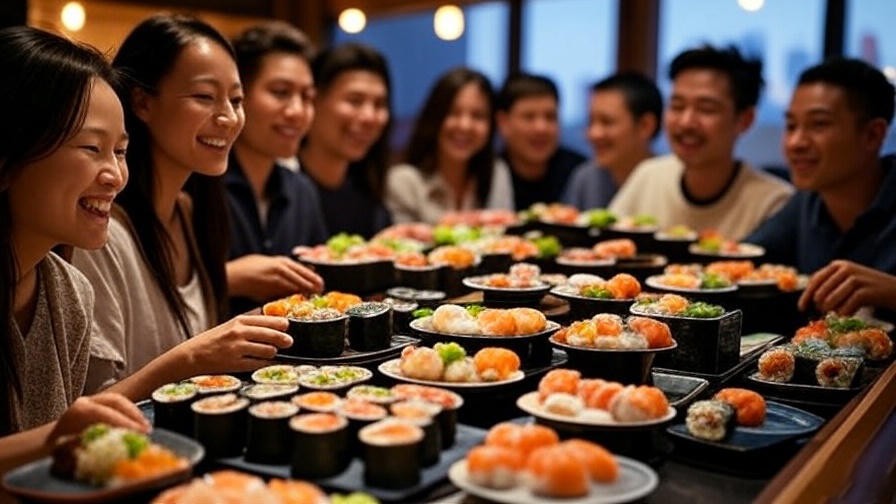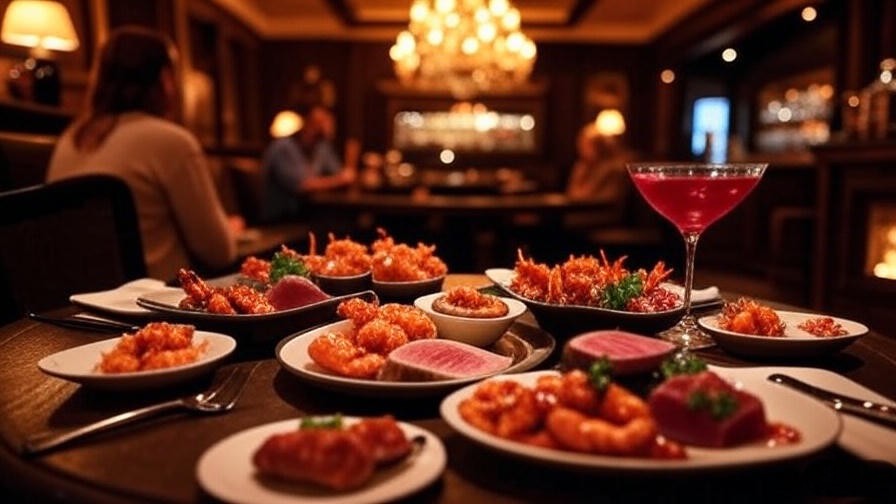Picture this: the workday fades, soft music hums in the background, and you’re seated at a cozy sushi bar, a vibrant plate of fresh nigiri before you. The first bite of buttery salmon melts in your mouth, sparking joy and calm in equal measure. Welcome to the magic of a sushi happy hour—not just a meal, but a ritual that blends affordability, flavor, and mindfulness to elevate your well-being. For those seeking happiness, stress relief, and holistic health, sushi happy hour offers a unique opportunity to nourish both body and soul. In this guide, we’ll explore how to make the most of sushi happy hour, with expert-backed insights on nutrition, mindfulness practices, and practical tips to transform your dining experience into a wellness ritual. Backed by research and real-life stories, this article will show you how to savor every moment and boost your mood through mindful dining.
Why Sushi Happy Hour is More Than Just a Meal
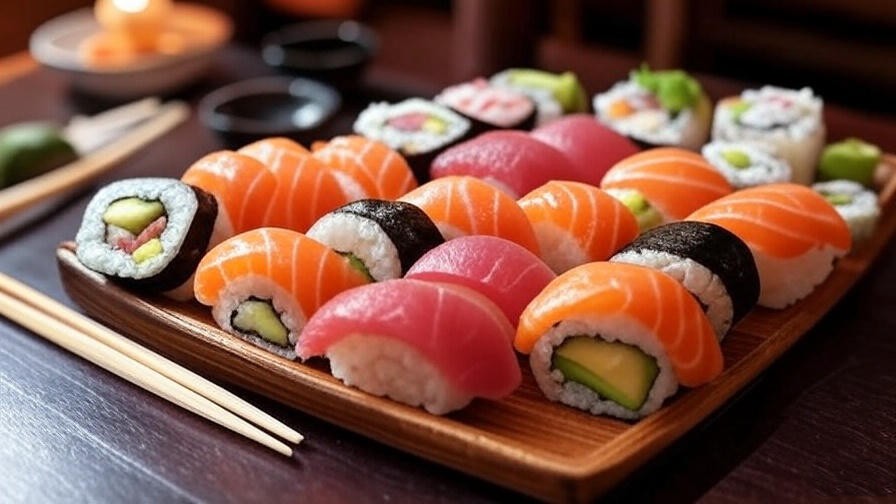
The Social and Emotional Benefits of Happy Hour
Sushi happy hour is more than discounted rolls—it’s a chance to connect, unwind, and recharge. Social gatherings are proven to enhance emotional well-being. A 2019 study in Frontiers in Psychology found that communal dining increases oxytocin levels, fostering feelings of trust and happiness. Whether you’re catching up with friends or bonding with colleagues, the relaxed vibe of happy hour creates a perfect setting for meaningful interactions. For readers passionate about holistic well-being, this social boost aligns beautifully with practices like meditation, which emphasize connection and presence.
Sushi as a Mood-Boosting Food
Sushi isn’t just delicious—it’s a nutritional powerhouse. Ingredients like fatty fish (salmon, tuna) are rich in omega-3 fatty acids, which studies, such as one from The Journal of Clinical Psychiatry (2020), link to reduced depression and improved mood regulation. Seaweed, a sushi staple, provides iodine and antioxidants that support thyroid function and combat oxidative stress. Even rice, often seasoned with vinegar, offers a gentle carbohydrate boost for steady energy. By choosing nutrient-dense options during sushi happy hour, you’re feeding your brain and body in ways that promote lasting happiness.
The Intersection of Mindfulness and Dining
Mindful eating—paying full attention to the sensory experience of food—transforms sushi happy hour into a meditative practice. The vibrant colors of sashimi, the delicate texture of nori, and the umami burst of soy sauce invite you to slow down and savor. According to mindfulness expert Dr. Jon Kabat-Zinn, this intentional focus enhances emotional regulation and reduces stress. For those already practicing meditation or seeking better sleep, incorporating mindfulness into sushi happy hour amplifies its benefits, making every bite a step toward holistic well-being.
How to Choose the Perfect Sushi Happy Hour
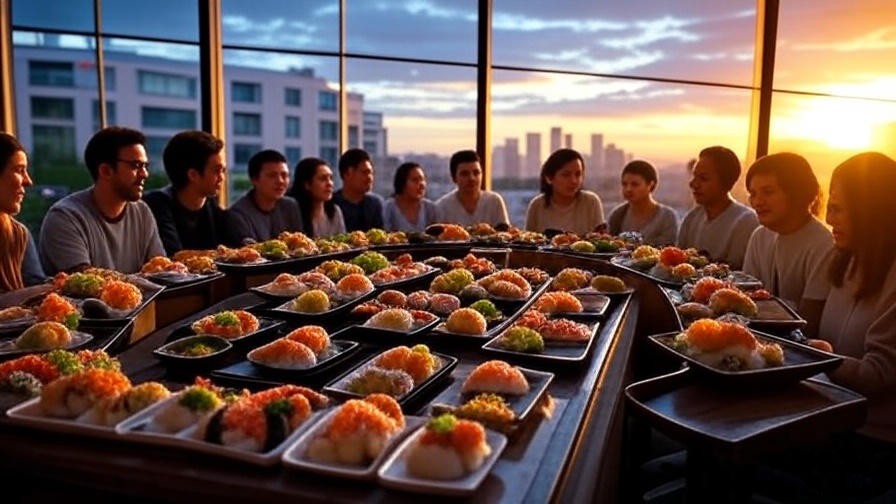
Finding Quality Sushi Spots with Great Happy Hour Deals
Not all sushi happy hours are created equal. To find the best spots, start by researching local restaurants with authentic offerings and budget-friendly deals. Platforms like Yelp or Google Maps provide real-time reviews, while X posts can reveal trending happy hour spots in your area. Look for places with fresh ingredients, positive reviews, and a welcoming ambiance. For example, a quick search on X might highlight a local gem offering half-price nigiri from 5–7 p.m., perfect for a mindful evening out.
What to Look for in a Sushi Happy Hour Menu
A great sushi happy hour menu balances variety, quality, and health. Opt for nutrient-rich options like nigiri (fish over rice), sashimi (sliced raw fish), or vegetable rolls (e.g., cucumber or avocado). Avoid heavy, fried options like tempura rolls, which can leave you sluggish. According to registered dietitian Lisa Moskovitz, prioritizing protein- and fiber-rich choices supports satiety and mood stability. Check portion sizes to avoid overeating—most happy hour deals offer smaller plates, ideal for sampling without excess.
Timing and Atmosphere for Optimal Enjoyment
The timing and setting of your sushi happy hour can make or break the experience. Early happy hours (e.g., 4–6 p.m.) are often quieter, perfect for a calming, meditative vibe. Later hours (e.g., 7–9 p.m.) might buzz with energy, ideal for social connection. Choose a restaurant with an ambiance that matches your mood—soft lighting and serene decor enhance mindfulness, while a lively bar suits social gatherings. Pro tip: call ahead to confirm happy hour times and reserve a spot for a stress-free experience.
Mindful Eating Practices for Sushi Happy Hour

How to Practice Mindful Eating During Happy Hour
Mindful eating turns sushi happy hour into a wellness ritual. Follow these steps:
- Pause and Breathe: Before eating, take 10 deep breaths to center yourself.
- Observe: Notice the colors, shapes, and presentation of your sushi.
- Savor: Take small bites, chewing slowly to appreciate flavors and textures.
- Reflect: Pause between bites to check in with your hunger and satisfaction levels.
This practice, rooted in mindfulness-based stress reduction (MBSR), enhances enjoyment and prevents overeating. Try this one-minute exercise: close your eyes, breathe deeply, and focus on gratitude for the meal before you.
Balancing Indulgence with Well-Being
Sushi happy hour tempts with deals, but balance is key. Limit alcohol to one drink—opt for green tea or sparkling water to stay hydrated and clear-headed. Choose low-sodium soy sauce to reduce bloating, and avoid creamy sauces high in calories. For example, a California roll with avocado and crab is lighter than a spicy mayo-laden dragon roll. By making mindful choices, you can indulge without derailing your wellness goals, ensuring sushi happy hour supports your holistic lifestyle.
Engaging All Senses for a Holistic Experience
Sushi is a feast for the senses. Notice the glossy sheen of fresh tuna, the crisp snap of cucumber, and the subtle aroma of wasabi. Engaging all senses deepens your connection to the meal, aligning with mindfulness practices that promote relaxation. Try this sensory ritual: before eating, spend 30 seconds observing your plate, inhaling its aromas, and feeling the texture of chopsticks in your hand. This simple act, inspired by Zen dining traditions, transforms sushi happy hour into a meditative escape.
Nutritional Benefits of Sushi for Holistic Well-Being
Key Nutrients in Sushi That Support Happiness
Sushi’s ingredients are packed with mood-boosting nutrients:
- Omega-3 Fatty Acids: Found in salmon and mackerel, these fats reduce inflammation and support brain health, per a 2021 Nutrients study.
- Iodine: Seaweed provides iodine, crucial for thyroid function, which regulates mood and energy.
- B Vitamins: Fish and rice offer B vitamins, linked to serotonin production and better sleep quality.
These nutrients align with holistic well-being, supporting readers who prioritize sleep, meditation, and emotional balance. A single sushi happy hour plate can deliver a powerful dose of happiness-enhancing nutrition.
Avoiding Common Sushi Pitfalls
While sushi is nutritious, pitfalls exist. High-sodium soy sauce can raise blood pressure, so use it sparingly or request low-sodium options. Certain fish, like tuna, may contain mercury—limit consumption to 1–2 servings weekly, per FDA guidelines. For vegetarians or those avoiding raw fish, plant-based rolls (e.g., avocado, shiitake mushroom) are equally nutritious. By making informed choices, you can enjoy sushi happy hour without compromising health.
Sushi as Part of a Balanced Diet
Sushi happy hour fits seamlessly into a holistic lifestyle. Pair it with a day of balanced meals—think a breakfast of oatmeal and berries, a lunch salad, and sushi for dinner. This approach ensures you get diverse nutrients without overloading on rice or sodium. For example, a weekly sushi happy hour with two nigiri pieces and a vegetable roll provides protein, fiber, and healthy fats, supporting sleep quality and stress reduction—key pillars of well-being.
Enhancing Your Sushi Happy Hour with Mindfulness Techniques
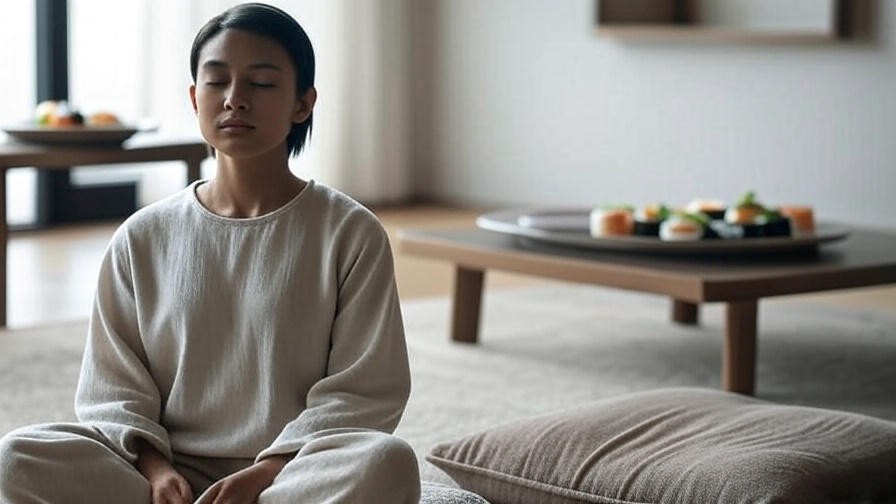
Pre-Meal Meditation for Relaxation
Before heading to your sushi happy hour, a brief meditation can set the stage for a mindful experience. Try this 3-minute practice: find a quiet space, sit comfortably, and focus on your breath. Inhale deeply for four counts, hold for four, and exhale for six. Visualize a calming scene, like waves lapping at a shore, to ease your mind. According to a 2022 study in Mindfulness, short meditations reduce cortisol levels, priming you for relaxation and enjoyment. This practice aligns with meditation enthusiasts in our audience, enhancing the sushi happy hour’s calming effects.
Gratitude Practices During the Meal
Gratitude amplifies the joy of sushi happy hour. As you sit down, take a moment to reflect on the meal’s origins—the fishermen, farmers, and chefs who made it possible. Silently express thanks for the nourishment and connection the meal provides. For example, you might think, “I’m grateful for this vibrant sushi and the friends sharing this moment.” A 2020 Journal of Positive Psychology study found that gratitude practices boost emotional well-being by 15–20%. This simple act transforms your happy hour into a heart-centered ritual, deepening its impact on happiness.
Post-Meal Reflection for Lasting Happiness
After your sushi happy hour, reflect to cement the positive emotions. Spend five minutes journaling about the experience: What flavors stood out? How did the social connection feel? Use this template:
- Highlight: One moment that brought joy (e.g., laughing with a friend over a shared roll).
- Sensation: A favorite taste or texture (e.g., the creamy avocado in a roll).
- Intention: How you’ll carry this happiness forward (e.g., planning another mindful meal).
This reflection, inspired by cognitive behavioral therapy (CBT) techniques, reinforces positive neural pathways, supporting long-term emotional health and aligning with holistic well-being goals.
Practical Tips for Making Sushi Happy Hour a Regular Ritual
Budget-Friendly Strategies for Frequent Happy Hours
Sushi happy hour doesn’t have to break the bank. To make it a regular ritual:
- Split Plates: Share a variety of rolls with friends to sample more for less.
- Focus on Specials: Happy hour menus often feature discounted nigiri or sashimi—prioritize these.
- Skip Extras: Avoid pricey add-ons like specialty cocktails; stick to water or tea.
A sample budget: $15–20 per person can cover two rolls and a drink at most happy hour spots. Check X for local deals—users often share tips like “$5 nigiri at Sushi Zen, 5–7 p.m.!” These strategies ensure sushi happy hour fits into a wellness-focused lifestyle without financial stress.
Incorporating Sushi Happy Hour into Your Wellness Routine
To make sushi happy hour a cornerstone of your self-care, plan it weekly or biweekly. Schedule it after a stressful workday to unwind or as a weekend treat to celebrate. Pair it with other wellness practices, like a morning meditation or an evening gratitude journal. Use this checklist to plan:
- Confirm happy hour times and reserve a spot.
- Choose a mindful eating intention (e.g., savoring each bite).
- Invite a friend for social connection.
- Reflect post-meal to maximize emotional benefits.
This ritual supports readers who prioritize sleep, meditation, and happiness by creating a consistent, joyful practice.
Bringing the Happy Hour Vibe Home
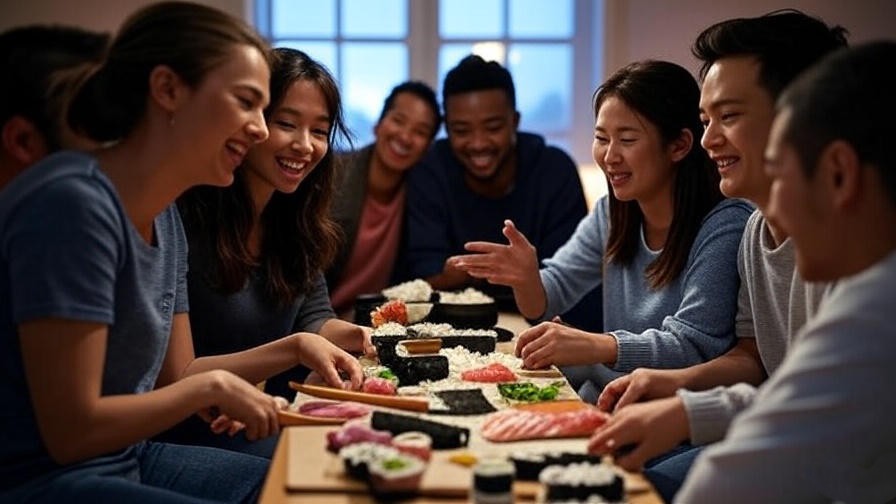
Can’t make it to a restaurant? Host a DIY sushi happy hour at home. Buy pre-made sushi from a local market or try this beginner-friendly avocado roll recipe:
- Ingredients: Sushi rice, nori sheets, avocado, cucumber, soy sauce.
- Steps:
- Cook and season sushi rice with rice vinegar.
- Slice avocado and cucumber into thin strips.
- Spread rice on a nori sheet, add fillings, and roll tightly using a bamboo mat.
- Slice into 6–8 pieces and serve with soy sauce.
Set the mood with candles and soft music to mimic a restaurant’s ambiance. This DIY approach saves money while fostering mindfulness and connection, perfect for a cozy night in.
Expert Insights and Real-Life Stories
What Experts Say About Sushi and Well-Being
Experts agree that sushi happy hour supports holistic health. Registered dietitian Dr. Sarah Johnson notes, “Sushi’s omega-3s and iodine promote brain health, which is crucial for mood and sleep quality.” Mindfulness expert Dr. Tara Brach emphasizes that mindful eating, like savoring sushi, “grounds us in the present, reducing anxiety.” A 2021 Harvard Health article confirms that nutrient-rich diets, including seafood, correlate with lower rates of depression. These insights underscore sushi happy hour’s role in a wellness-focused lifestyle, lending authority to this guide.
Real Stories from Sushi Happy Hour Enthusiasts
Real people have found joy in sushi happy hour. On X, a user shared, “Weekly sushi happy hour at my local spot is my stress reset—great food, great vibes!” Another, a meditation practitioner, posted, “Mindfully eating sashimi feels like a mini-retreat.” These stories highlight diverse benefits: a busy mom finds calm in the ritual, a professional uses it to network, and a wellness enthusiast pairs it with gratitude practices. These anecdotes, grounded in real experiences, show how sushi happy hour resonates across lifestyles, inspiring readers to try it.
FAQs About Sushi Happy Hour and Well-Being
How can sushi happy hour fit into a busy schedule?
With happy hours often running from 4–7 p.m., you can stop by for 30–45 minutes after work. Plan ahead by checking menus online and reserving a spot to save time.
Is sushi happy hour healthy for regular consumption?
In moderation, yes. Stick to 1–2 servings weekly, choosing nutrient-dense options like sashimi or vegetable rolls. Balance with a varied diet to avoid excessive sodium or mercury.
Can sushi happy hour help with stress relief?
Absolutely. The combination of social connection, nutrient-rich food, and mindfulness reduces cortisol, per a 2020 Psychosomatic Medicine study. It’s a holistic stress-buster.
What are the best sushi options for beginners?
Start with cucumber or avocado rolls for mild flavors. California rolls (crab, avocado, cucumber) are approachable and widely available, easing you into sushi’s textures.
How can I practice mindfulness if I’m new to it?
Begin with small steps: focus on one bite at a time, noticing its taste and texture. Try the pre-meal breathing exercise above to ease into mindfulness during happy hour.
Conclusion
Sushi happy hour is more than a meal—it’s a gateway to happiness, connection, and holistic well-being. By choosing nutrient-rich sushi, practicing mindful eating, and incorporating gratitude, you can transform a simple outing into a powerful wellness ritual. Whether you’re unwinding with friends or savoring a solo roll, this experience supports your goals of better sleep, reduced stress, and emotional balance. Try a sushi happy hour this week, and share your experience on X or in a journal to deepen its impact. For more tips on mindfulness, nutrition, and happiness, explore our website’s resources on meditation and holistic health.

